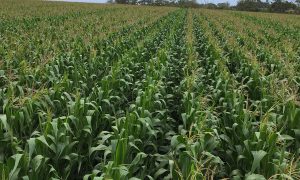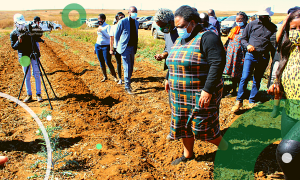From time immemorial, communities in South Africa and the rest of Africa have always relied on indigenous farming knowledge to feed and for food security.
This knowledge has proven to be effective over the years and is still as effective today as it was back then.
A study conducted by Sejabaledi Agnes Rankoana has shown that indigenous knowledge, which is embedded in the community’s cosmology, is still valuable today.
The paper is titled – The Use of Indigenous Knowledge in Subsistence Farming: Implications for Sustainable Agricultural Production in Dikgale Community in Limpopo Province, South Africa.
These indigenous practices, the study finds, could be helpful in the achievement of the United Nations’ Sustainable Development Goal on food security, which requires a nutritionally adequate and safe food supply at household levels.
The study examined community-based mechanisms of continued subsistence farming under unfavourable environmental conditions. Semi-structured interviews conducted with a sample of 250 participants showed that community members sustain farming through their indigenous knowledge. Community members continue subsistence farming in their home-gardens and ploughing fields through indigenous farming practices and rainfall prediction.
The practices involve improvement of soil fertility and structure, maintenance of crops, and seed selection and storage for future planting. Knowledge of rainfall prediction is helpful in planning the planting season.
The study finds that knowledge of plant phenology, and the appearance and shape of the moon and stars is used to plan the planting of crops. The materials used to fertilise the soil, mulch, manage crops, and the seeds are procured at the household level. Soil fertilizers, mulching ingredients and crop management materials are locally developed, always available, affordable, and culture-specific.
The study concludes that subsistence farming is sustained by indigenous farming practices and rainfall prediction. The practices involve the improvement of soil structure, maintenance of crops, and the selection and storage of seeds for replanting.
Rainfall prediction helps community members plan the planting season. This indigenous knowledge is self-developed and relied upon to generate sustained crop yields to meet subsistence needs. The indigenous knowledge could be helpful towards the achievement of food security at the household level. The knowledge could also make contributions to the development of sustainable adaptation policies to assist rural communities which are vulnerable to climate change hazards.
The participants addressed questions relating to the indigenous knowledge community members use to sustain subsistence farming. The responses provided show that community members use their indigenous farming practices such as planting on different soil types, soil fertilization, selection and storage of seeds and maintenance of crops. In addition to these knowledge systems the participants mentioned the use of knowledge of rainfall forecast.
These indigenous knowledge systems are produced by local people based on their lived experiences:
Rainfall Forecast
It was established during the study that the participants use signs, such as the sprouting tree leaves and flowers, to predict rainfall. The beginning of summer is marked by the flowing and leaf sprouting of Senegali species. In addition to this plant phenology, the appearance of stars, moon, and the sun are carefully observed at the beginning of September, which marks the beginning of a new season. It is believed that the signs of these celestial bodies denote a good or bad season.
For example, 78% of the participants showed that if mahlapolane (Mars) lies towards the west, it predicts a good year, but if it disappears towards the east, it predicts a bad season with little rain. It is also believed that if the horns of the crescent moon point towards the Earth, it pours out rain, but if it points away from the Earth, it holds the rain. This indigenous knowledge of forecasting is used to plan the planting season. Whenever a bad season is predicted, farming will not be done until it rains sufficiently.
The participants’ knowledge of rainfall prediction corroborates Speranza’s findings that local farmers possess knowledge on the use of local indicators, such as plants, birds, insects, and astronomy, in predicting rainfall. Kijazi attests that people use the behaviour of animals and plants to predict the coming agricultural season. Chang’a show that this type of indigenous knowledge is important in farm decision-making to respond to anticipated poor yields. The use of Senegali phenology to predict rainfall in the study is also used by Malunga farmers in Tanzania to forecast the upcoming rainy season.
The participants’ use of celestial bodies to predict rain is corroborated by the use of the moon and the stars by Chibelela farmers. The farmers use the moon’s shape and colour as signs to predict a season of either sufficient or scarce rainfall. They also use the movement of stars to make inferences about the rainfall patterns for a specific season of the year. Equally, in Uganda the farmers use local indicators, such as phases and shapes of the moon, to predict upcoming weather.
Knowledge of Soil Types
Knowledge of soil varieties by colour and texture, and the types of crops that do well on particular soil types, was evident among the participants. According to the participants, black clayey soil is rich in nutrients and good for cultivation of maize, pumpkin, and gourds. Sandy soil is good for beans, melons, and sweet-reed. Another type of soil is a mixture of sandy and clayey soil which is good for all crops. These findings are supported by observations that Zulu subsistence farmers’ knowledge of soil is based on colour and texture of the topsoil, that dark soil indicates higher fertility while lighter soil signifies lower fertility.
Mulching
It was reported that previous harvest residue in the form of maize stalks, dried bean and nut plants is a good soil stabiliser. The participants reported that after harvest, the residue is tilled with the soil to improve moisture retention and fertility of the soil. This indigenous practice, according to Buthelezi, replenishes depleted soil nutrients.
Soil Fertilization
The participants reported that they apply kraal and poultry manure to make the soil regain fertility, retain moisture, and avoid pests. This type of soil fertilization mainly improves soil moisture conservation. In Tanzania, subsistence farmers understand that if weeds are left to grow, they cover the soil, prevent it from heating up or drying out excessively, induce a positive competition, which simulates crop growth and reduces erosion during rainfall.
Seed Selection
The participants reported that, subsequent to harvesting, the crops are threshed and carefully stored for use. The seeds are carefully selected for planting in the next season. Good seeds are selected by colour. Only bright coloured and large-sized seeds are selected for planting. Sometimes selection of the best seeds is done by soaking the seeds in water. Only the sinking seeds are selected and the floating seeds are not selected. Olatokun and Ayanbode observe that Nigerian women cull the seeds and preserve them for the next planting season. In Ethiopia, the farmers select healthy crops in terms of maturity period, height, colour, and size. The panicles or the spikes of the selected varieties are separately harvested, dried, carefully threshed, and the grains are saved for replanting.
Multiple Cropping
Sowing of seeds is done haphazardly by hand. All seed varieties are sown simultaneously in the same field. This practice maximises the growth of all crops at the same time in the same field. Inter-planting allows cropping systems to reuse their own stored nutrients. With this system productivity per unit area is higher than in mono-cropping systems with the same level of management. The farmers incorporate a variety of crops with different growth habits in the same field or home-gardens to maximise the chances for production of multiple crops.
Maintenance of Crops
It was reported that subsequent to planting, when the crops are about four weeks old, weeding commences. Weeds are removed by hand or hand-hoe to avoid them competing for moisture with the crops, thus disturbing the growth of crops. In Tanzania, when the farmers regard weed competition as negative for crop growth, they perform superficial hoeing, and leave the weeds on the soil surface as protective mulch, to recycle nutrients, and to allow nitrogen assimilation through the bacteria decomposing the plants.
For the participants, when the crops are about to reach maturity, the women, boys, and girls spend days in the fields scaring birds off the crops. In many instances a “go-upa” ritual is performed through dispensing of medicine obtained from traditional health practitioners in the field to permanently remove birds and marauding animals from the fields. Olatokun and Ayanbode observe that tobacco (Nicotiana tabacum) plants are used to prevent insect build-up on the cocoa plantation. In Indonesia, the farmers burn the common lake-growing plant called Jariamun (Potamogeton. malaianus miq) in the middle of the rice-field to drive pests from the farm.
Storage of Seeds and Crops
After harvesting and threshing, the crops are stored and prevented from attack by weevils. The crops remain fresh until they are all consumed. The most common preservation practice mentioned by the participants is by hanging the maize, sorghum and millet cobs from the hut roof. Sometimes the seeds are mixed with the ash of Aloe ferox and stored into clay-pots and baskets. The seeds could last for more than five seasons. Chili pepper (Capsicum annum.) is used to preserve harvested cowpea in storage.
Fallowing
In many instances exhausted fields are left fallow for two to five years. The participants agreed that this practice helps the soil regain fertility. During fallowing, cattle, sheep and goats are driven in the fields to browse course grass and that their droppings should add to soil fertility. Fallowing enables farmers capture the essence of natural processes of soil regeneration typical of ecological succession. The use of “green manures”, which is a recent discovery, intensifies the old fallowing technique in areas where long fallow periods are not possible anymore.




















